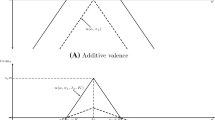Abstract
In contrast to the traditional modeling of voter choice based on proximity, under directional models, selection of candidates is based on the direction and/or intensity of change from a status quo or neutral point. Voter choice can also be modeled as representing both approaches, e.g., as a directional model with proximity restraint, or alternatively, in terms of proximity to discounted positions.
We provide a unified perspective for these seemingly disparate models in terms of what we call “shadow” positions. We demonstrate that voter choice in a variety of spatial models including directional components can be viewed as proximity-based choices. Voters choose the candidate whose shadow is nearer, where shadow locations are defined by a simple transformation. We apply this approach to equilibrium analysis, showing that results for a discounted proximity model can be carried over – via shadows – to a variety of directional models.
Similar content being viewed by others
References
Carroll, J.D. (1972). Individual differences and multidimensional scaling. In R.N. Shepherd, A.K. Romney, and S. Nerlove (Eds.), Multidimensional Scaling Theory and Applications in the Social Sciences, Vol. I, Theory. New York: Seminar Press, 105–155.
Cohen, L. and Matthews, S.A. (1980). Constrained Plott equilibria, directional equilibria, and global cycling sets. Review of Economic Studies 47: 975–86.
Damgaard, E. (1969). The parliamentary basis of Danish governments: patterns of coalition formation. Scandinavian Political Studies 4: 30–58.
Davis, O., Hinich, M.J. and Ordeshook, P.C. (1970). An expository development of a mathematical model of policy formation in a democratic society. American Political Science Review 64: 426–448.
De Soete, G. and Carroll, J.D. (1983). A maximum likelihood method of fitting the wandering vector model. Psychometrika 48: 553–566.
Dow, J. (1995). Directional and proximity models of voter choice in recent U.S. presidential elections. Paper presented at the Meeting of the Western Political Science Association, Portland, OR.
Downs, A. (1957). An Economic Theory of Democracy. New York: Harper and Row.
Enelow, J.M., Endersby, J.W. and Munger, M.C. (1993). A revised probabilistic spatial model of elections: theory and evidence. In Bernard Grofman (Ed.), Information, participation and choice: ‘An economic theory of democracy’ in perspective. Ann Arbor MI: University of Michigan Press, 125–140.
Enelow, J.M. and Hinich, M.J. (1990). Advances in the spatial theory of voting. New York: Cambridge University Press.
Grofman, B. (1985). The neglected role of the status quo in models of issue voting. Journal of Politics 47: 230–237.
Iversen, T. (1994). Political leadership and representation in west European democracies: a test of three models of voting. American Journal of Political Science 38: 45–74.
Listhaug, O., Macdonald, S.E. and Rabinowitz, G. (1991). The role of issues in elections: voting decisions in Norway and the United States. Paper presented at the Annual Meeting of the American Political Science Association, August 28–September 1, Washington, DC.
Macdonald, S.E., Listhaug, O. and Rabinowitz, G. (1991). Issues and party support in multiparty systems. American Political Science Review 85: 1107–1131.
Matthews, S.A. (1979). A simple direction model of electoral competition. Public Choice 34: 141–156.
McKelvey, R. (1986). Covering, dominance, and institution free properties of social choice. American Journal of Political Science 30: 283–314.
Merrill, S., III. (1993). Voting behavior under the directional spatial model of electoral competition. Public Choice 77: 739–756.
Merrill, S., III. (1994). A probabilistic model for the spatial distribution of party support in multiparty electorates. Journal of the American Statistical Association 89: 1190–1197.
Merrill, S., III. (1995). Discriminating between directional and proximity spatial models of electoral competition. Electoral Studies 14: 273–287.
Merrill, S., III, and Grofman, B. (1996). Directional and proximity models of spatial two-party competition: a new synthesis. Journal of Theoretical Politics (forthcoming).
Merrill, S., III, Grofman, B. and Feld, S.L. (1996). Nash equilibrium strategies in directional models of two-candidate spatial competition. Paper presented at the Annual Meeting of the Public Choice Society, Houston, TX, April 12–14.
Platt, G., Poole, K. and Rosenthal, H. (1992). Directional and Euclidean theories of voting behavior: a legislative comparison. Legislative Studies Quarterly 17: 561–572.
Rabinowitz, G. and Macdonald, S.E. (1989). A directional theory of issue voting. American Political Science Review 83: 93–121.
Rabinowitz, G. and Macdonald, S.E. and Listhaug, O. (1991). New players in an old game: party strategy in multiparty systems. Comparative Political Studies 24: 147–185.
Rabinowitz, G. and Macdonald, S.E. and Listhaug, O. (1993). Competing theories of issue voting: is discounting the explanation? Paper presented at the Annual Meeting of the American Political Science Association, Washington DC, September 2–5.
Westholm, A. (1995). Distance versus direction: the illusory defeat of proximity theory. Department of Government, Uppsala University. Typescript.
Author information
Authors and Affiliations
Rights and permissions
About this article
Cite this article
Merrill, S., Grofman, B. Conceptualizing voter choice for directional and discounting models of two-candidate spatial competition in terms of shadow candidates. Public Choice 95, 219–231 (1998). https://doi.org/10.1023/A:1004934108042
Issue Date:
DOI: https://doi.org/10.1023/A:1004934108042




